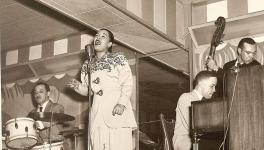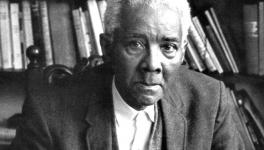The Harriet Tubman Mural That Transcends Time
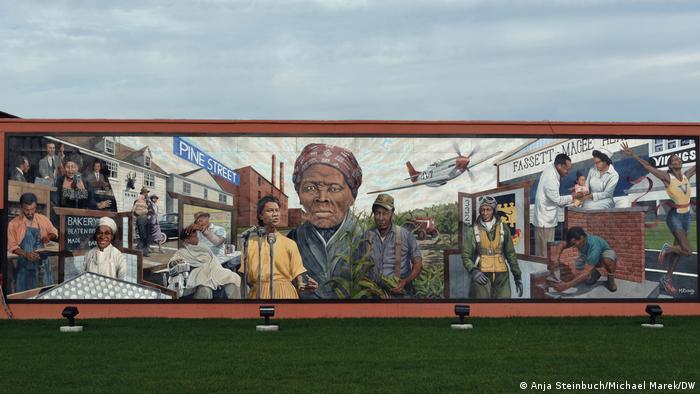
Michael Rosato's mural 'Reflections on Pine' is centered around Harriet Tubman
Tubman Country. It's what inhabitants proudly call a stretch of land on the East Coast of the United States. Washington, D.C. is just over two hours away by car, but traveling to visit the area invites a journey back in time.
The peaceful, maritime region located in the state of Maryland once played a notorious role in the trans-Atlantic slave trade. In 1619, the first slave ship docked here carrying Africans who had been kidnapped in what is now Angola.
It is also here, on this segment of land surrounded by the Chesapeake Bay and the Atlantic Ocean, that Harriet Tubman was born, very likely in mid-March 1822, though no one knows for sure.
Born into slavery, Tubman later escaped north to freedom. She then became an abolitionist and one of the most famous participants in the Underground Railroad, a secret safe house network that helped enslaved African Americans travel north to freedom.
She led at least several dozen enslaved individuals to freedom — all at great risk to her own life. She also fought for women's suffrage and Black rights.
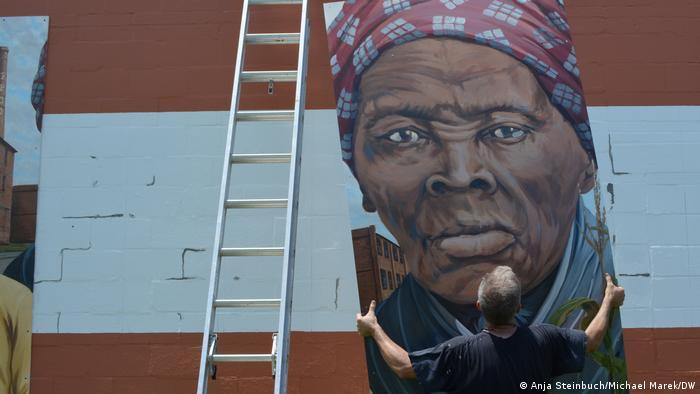
Michael Rosato's murals are gigantic, as can be seen in this photo showing him hanging the portrait panel of Harriet Tubman
'Triumph of the human spirit'
Artist Michael Rosato is waiting at the entrance to Cambridge, a town in Maryland of 12,000 people. The artist, in his mid-50s, is known for his giant works of street art that often depict figures of American history.
Today, he is standing in front of his 50-square-meter mural "Reflections on Pine" (pictured at the top of this article).
The huge, colorful mural shows Tubman as an old woman with a headwrap and coat, standing in a cornfield. Above her is a military plane while next to her are portrayals of Black artists, scientists and politicians, other heroes of history, all of whom emanate from her portrait. What immediately catches the eye is that the perspective seems shifted: We are not looking at Harriet; she is defining us as the viewer.
Harriet was one of those special individuals whose human spirit was greater than anything else, Rosato says: "And to do that took a lot of courage and a lot of faith and just a lot of fortitude."
The artist says he put Tubman at the center of his painting because she played such an important role for many African Americans. "[She] is the inspiration for many African Americans in the community. You know, 'When she could do it, then I can do it,'" he says.
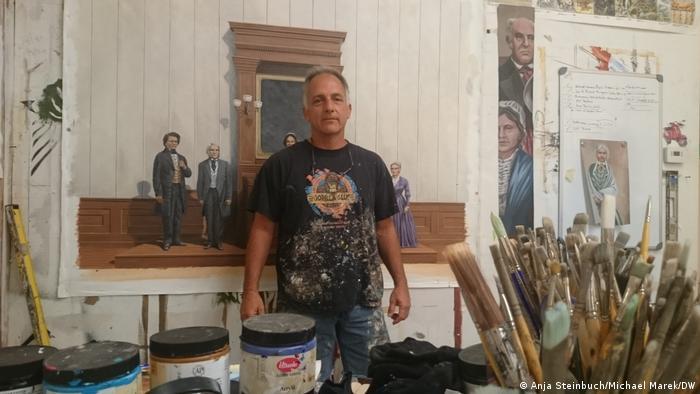
Artist Michael Rosato in his studio in Cambridge, Maryland
Capturing a vibrant Black community
Her legacy contributed to an active Black civil rights movement in Cambridge.
The streets of its Black community were once a lively collection of stores, cafes, and schools, but things changed after the riots and confrontations with police that occurred in the 1960s.
The mural recalls the vibrant times of the past. "When you look at that mural, there are a lot of things happening in it. That tells the story of a community," Rosato explains, adding that Tubman was the basis of that community.
Rosato's large-scale works in public spaces have generated discussion and received great acclaim. "I thought in designing this, you have to incorporate things that the community, both sides, white and Black, can identify with."
Reaching out, transcending time
Another mural by Rosato, "Take my hand," shows Tubman by a river. She appears to be stepping over a wall and out of the painting as she extends her right hand to viewers, open and ready to take someone's hand in hers. A photo of a girl symbolically reaching out to the larger-than-life Tubman went viral on social media in 2019.
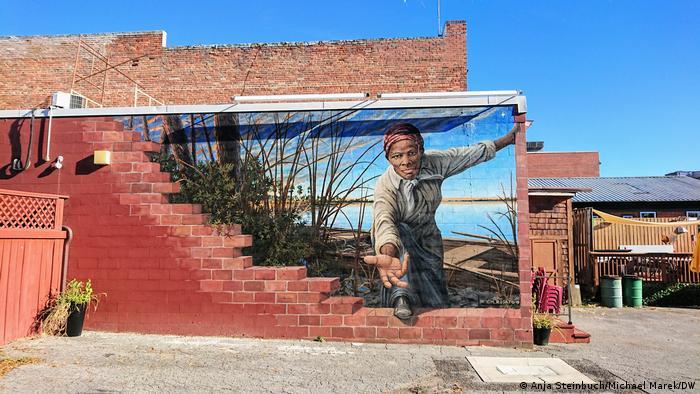
The mural 'Take my hand' by Michael Rosato shows a young Harriet Tubman reaching out to the viewer
At that time, a repressed anger was changing the US, Rosato says. "The Black community was getting tired of the police shooting[s], they were getting tired of this pent-up acceptance of how they've been treated." All of a sudden, it wasn't just about the painting but also about the young child Tubman touches. For Rosato, this was poetic, and it was moving.
"Young girl, present day, touching the hand of a woman from 200 years ago. That poetry is, I think, what spoke and what really got people, because [it] allowed them to be that little girl and to be this woman, offering a hand."
Only a few photos of Tubman exist. She is always looking seriously into the camera. This is also the case in the best-known black-and-white picture from 1895, taken when she was 73. While Rosato did use the historical image as a model, he chose to paint the slave emancipator in "Take my hand" at the age of 30. He wanted to show a young, rebellious Harriet and saw it as connected to the Black Lives Matter movement.
The mural not only depicts Tubman but also shows the landscape where she had lived when she was enslaved — the place where she had to toil as the "property" of a white plantation owner and received whippings as a 6-year-old.
When you look at the mural, you're looking into the past, Rosato explains. You can see the vegetation and the water. "And she is transcending time, in a way, because she is offering her hand to us the viewer in the present," he says.
Some 14-feet (4 meters) tall and with hands measuring 3 feet (0.9 meters), Tubman is monumental in size. "It's big — it's imposing, it's not life size, it's larger than life!" Rosato says. "So you are engaging with this larger-than-life woman who is reaching through this wall and part of her foot is painted trompe l'oeil, tricking the eye, to look like it's coming out and into your space."
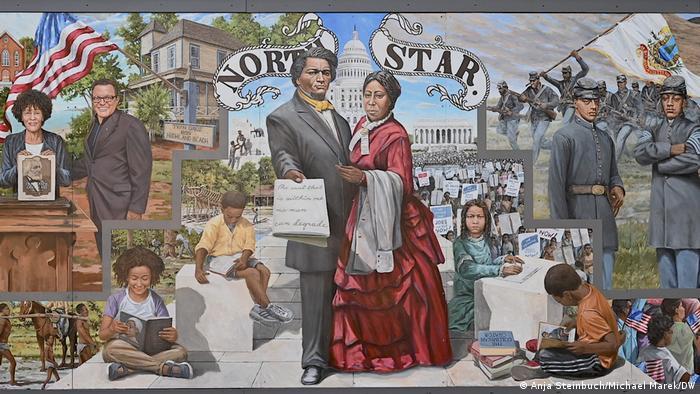
This mural by Rosato centers on African American abolitionist and reformer couple Frederick and Anna Douglas
Amending historic wrongs
Connecting the past and present also has to do with belated efforts to amend historic wrongs and reparations that many governments in the US, from the local to the state to the federal, have struggled to make.
Tubman not only helped her fellow enslaved countrymen and women to freedom; she fought in the Civil War against the Southern slave-owning states, scouting out Confederate positions, and she also served as a nurse.
Despite her services, she was denied a pension. It was not until she was in old age, shortly before her death in 1913, that she finally received a monthly pension for her nursing work. She lived to be 91.
This article was originally written in German
Get the latest reports & analysis with people's perspective on Protests, movements & deep analytical videos, discussions of the current affairs in your Telegram app. Subscribe to NewsClick's Telegram channel & get Real-Time updates on stories, as they get published on our website.














